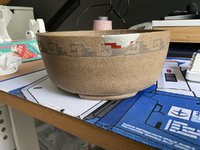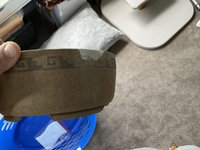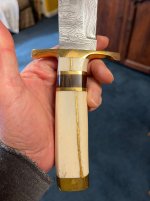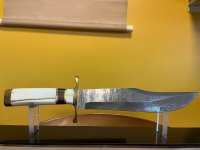You are using an out of date browser. It may not display this or other websites correctly.
You should upgrade or use an alternative browser.
You should upgrade or use an alternative browser.
Kintsugi Pot Repair
- Thread starter lieuz
- Start date
-
- Tags
- kintsugi lacquer pot repair
JudyB
Queen of the Nuts
I like the string added to the handle, will it remain when the repair is complete?
rockm
Spuds Moyogi
Nice job! I have Jim Flanagan pot similar to this one. Really like the Southwestern designs on them. Glad you reconstructed it.Update on this pot repair. I’ve added the design back into the repair.
View attachment 548619
Here it is gilded with tin.
View attachment 548620
Now to wait for it to cure.
lieuz
Chumono
I'll smooth it down considerably, the string's fibrous material is what I'm after to create a strong bond. Eventually, it'll look like a band around the handle.I like the string added to the handle, will it remain when the repair is complete?
lieuz
Chumono
Thank you! I got a chance to see him at the PBA show, he explained his design concepts to me and I showed the repaired piece to him and he was quite content in seeing it being repaired.Nice job! I have Jim Flanagan pot similar to this one. Really like the Southwestern designs on them. Glad you reconstructed it.
lieuz
Chumono
The cup handle is officially cured and rock hard. I had sanded down the mugi-urushi string reinforcement to reveal the string fibrous material very secured into the mugi-urushi. It's now very hard and able to take on quite a bit of weight. So far, the tested weight is 10 lbs. That's pretty substantial and enough for this cup since nothing will be in the cup that'll be 10 lbs or more.
Here's what sanding revealed. The string has bounded to itself and to the mugi-urushi.

The are more frayed fibers but I've burned it off to keep things tidy for the next step.

The underside was a bit harder to sand. I left the underside a bit more bulky for support, less sanding than the top.

Fairly uniform, the string is going to provide a great amount of support. Note the ight side is curved a bit, I sanded it a bit too much and will have to come back with filler anyway to level it out. No worries.

Next step would be to tape this back up and reapply sabi-urushi to bind the entire top together before I buff the area out with charcoal. Should look pretty good! Going to bring this to work to show my coworker the work in progress.
Here's what sanding revealed. The string has bounded to itself and to the mugi-urushi.

The are more frayed fibers but I've burned it off to keep things tidy for the next step.

The underside was a bit harder to sand. I left the underside a bit more bulky for support, less sanding than the top.

Fairly uniform, the string is going to provide a great amount of support. Note the ight side is curved a bit, I sanded it a bit too much and will have to come back with filler anyway to level it out. No worries.

Next step would be to tape this back up and reapply sabi-urushi to bind the entire top together before I buff the area out with charcoal. Should look pretty good! Going to bring this to work to show my coworker the work in progress.
JudyB
Queen of the Nuts
Are you going to cover the string or treat it with something for coloration? I like the texture it adds.The cup handle is officially cured and rock hard. I had sanded down the mugi-urushi string reinforcement to reveal the string fibrous material very secured into the mugi-urushi. It's now very hard and able to take on quite a bit of weight. So far, the tested weight is 10 lbs. That's pretty substantial and enough for this cup since nothing will be in the cup that'll be 10 lbs or more.
Here's what sanding revealed. The string has bounded to itself and to the mugi-urushi.
View attachment 551667
The are more frayed fibers but I've burned it off to keep things tidy for the next step.
View attachment 551668
The underside was a bit harder to sand. I left the underside a bit more bulky for support, less sanding than the top.
View attachment 551669
Fairly uniform, the string is going to provide a great amount of support. Note the ight side is curved a bit, I sanded it a bit too much and will have to come back with filler anyway to level it out. No worries.
View attachment 551670
Next step would be to tape this back up and reapply sabi-urushi to bind the entire top together before I buff the area out with charcoal. Should look pretty good! Going to bring this to work to show my coworker the work in progress.
lieuz
Chumono
Yeah, I'm going to cover it up. The texture is pretty cool. I've seen a lot of examples where the texture is preserved too. I'll have to see how it looks once I polish it down with charcoal.Are you going to cover the string or treat it with something for coloration? I like the texture it adds.
lieuz
Chumono
I've applied the sabi urushi on to fill in all the string but before I did that, I did put on a layer of raw urushi to let the string soak it all in. Doing this I think will help with strengthening the structure. Mugi urushi as an adhesive doesn't really soak into the string as you see on the previous step. It's like impregnating the string with the urushi to ensure it doesn't also grow moldy and deteriorate.
Here is the added filler material on.


Next step, is wait a few days to let this cure and peel off all the tape to reveal the filled in areas.
Here is the added filler material on.


Next step, is wait a few days to let this cure and peel off all the tape to reveal the filled in areas.
lieuz
Chumono
Few days later, tape was removed. Fairly accurate tape job.

Sanding down commences


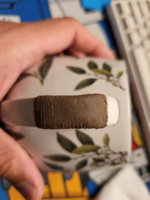
The edges are fairly high, what ended up happening was i sanded it some more and the thresholds for transitioning from cup to the repair is as low as possible.

Next step is to apply polishing urushi to fill in all the ridges.

Sanding down commences



The edges are fairly high, what ended up happening was i sanded it some more and the thresholds for transitioning from cup to the repair is as low as possible.

Next step is to apply polishing urushi to fill in all the ridges.
lieuz
Chumono
Painting day! I love this part of the process because it really validates the previous steps.



I'll come back in and use 400-600 grit and refine those edges as well as those ridges. Then I'll add another layer of polishing Urushi. The goal for me is to get it to be smooth without indication of any ridging. More to come!



I'll come back in and use 400-600 grit and refine those edges as well as those ridges. Then I'll add another layer of polishing Urushi. The goal for me is to get it to be smooth without indication of any ridging. More to come!
lieuz
Chumono
After this repair, I'll keep it focused it on just bonsai pots haha.
JudyB
Queen of the Nuts
maybe I could send you my pot that was done with epoxy to see what you might be able to do for it… warning, it’s a lot of seams!After this repair, I'll keep it focused it on just bonsai pots haha.
lieuz
Chumono
Sure if you're interested! I'll DM you to talk.maybe I could send you my pot that was done with epoxy to see what you might be able to do for it… warning, it’s a lot of seams!
lieuz
Chumono
After a few more rounds of polish and sanding, I'm ready to call it done before I apply the lacquer for gilding. I gave it a lot of thought @JudyB about your comment about the texture. I think you're right that texture adds something to this repair. I asked the owner and he said he's up for anything. I gave it more thought and wanted to try the texture idea. I didn't want to use the ribbed texture, although, I think that'd be a great texture for gripping. I wanted it to be organic like the cup design. It dawned on me that the lacquer itself can create some naturally interesting designs.
Generally speaking, this is a taboo no no when it comes to kintsugi repair, mainly because it shows impatience. Basically, if you load up polishing lacquer and you apply it to the surface, if the outside lacquer cures quickly, it'll contract within and create these very weird striations. They're not always the same striations, but it's in general a wrinkly looking texture. So it shows that you can't control lacquer application and, you can't control the humidity well enough. Amateur hour, if you will. However, if you're intentionally doing so to get an effect, this is an awesome technique.

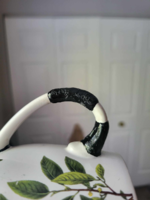
I can't wait to see what it looks like gilded.
Generally speaking, this is a taboo no no when it comes to kintsugi repair, mainly because it shows impatience. Basically, if you load up polishing lacquer and you apply it to the surface, if the outside lacquer cures quickly, it'll contract within and create these very weird striations. They're not always the same striations, but it's in general a wrinkly looking texture. So it shows that you can't control lacquer application and, you can't control the humidity well enough. Amateur hour, if you will. However, if you're intentionally doing so to get an effect, this is an awesome technique.


I can't wait to see what it looks like gilded.
JudyB
Queen of the Nuts
Love it. It adds instead of distracts.After a few more rounds of polish and sanding, I'm ready to call it done before I apply the lacquer for gilding. I gave it a lot of thought @JudyB about your comment about the texture. I think you're right that texture adds something to this repair. I asked the owner and he said he's up for anything. I gave it more thought and wanted to try the texture idea. I didn't want to use the ribbed texture, although, I think that'd be a great texture for gripping. I wanted it to be organic like the cup design. It dawned on me that the lacquer itself can create some naturally interesting designs.
Generally speaking, this is a taboo no no when it comes to kintsugi repair, mainly because it shows impatience. Basically, if you load up polishing lacquer and you apply it to the surface, if the outside lacquer cures quickly, it'll contract within and create these very weird striations. They're not always the same striations, but it's in general a wrinkly looking texture. So it shows that you can't control lacquer application and, you can't control the humidity well enough. Amateur hour, if you will. However, if you're intentionally doing so to get an effect, this is an awesome technique.
View attachment 557246
View attachment 557247
I can't wait to see what it looks like gilded.
rockm
Spuds Moyogi
Coppersdad
Mame
My humble and respectful thanks to each of you who posted and commented in this thread.
My "favorite" pot from a California potter was shattered during our recent bomb cyclone windstorm.
Although it will never again contain a tree, I vowed to restore it with what will be my first attempt with Kintsugi.
Each post in this thread has been inspiring, informative and the multiple pictures of the various techniques of clamping have answered many of my questions.
My "favorite" pot from a California potter was shattered during our recent bomb cyclone windstorm.
Although it will never again contain a tree, I vowed to restore it with what will be my first attempt with Kintsugi.
Each post in this thread has been inspiring, informative and the multiple pictures of the various techniques of clamping have answered many of my questions.
Similar threads
- Replies
- 20
- Views
- 2K

